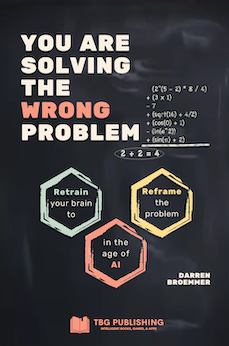From the book "You are Solving the Wrong Problem"Chapter 17: Greenfield vs Current Constraints
“The highest form of creativity is found by improvising within a set of restrictions.” –Christopher Nolan
If you had no constraints at all, what would you do? Wikipedia has a good definition for a greenfield project, which is "one that lacks constraints imposed by prior work." This is the Diamond Pattern at its most extreme. You can fan-out as wide as you can possibly imagine. Any option is on the table. Many engineers live for the day when they get to work on a greenfield project.
Most of us need to work within the current constraints. When we work as part of an organization, we need to convince management if any constraints are to be removed. Usually, this requires additional funding or adopting changes outside the normal business practices.
Bill Carr is the co-author of the book "Working Backwards." He spent 15 years at Amazon and now runs a consulting firm called Working Backwards LLC. On a recent podcast, he said that you "start with what's best for the customer and then come backward from there". Note that you don't do what is easiest for you. You do what makes the most sense for the customer. Once you define that as a target, you can scope out the work needed to get there. Those are now the problems you need to solve. Given the size and resources of Amazon, even big problems could be efforts the company decides to undertake. For smaller organizations or even individuals, there is a stringent focus on feasibility. How big is that gap, and how much work is needed to close it?
Mr. Carr goes on to say, "If we served customers well, if we prioritized customers and delivered for them, things like sales, things like revenue and active customers and things like the share price and free cash flow would follow." I love this quote because it puts the important things first. It puts faith in doing the right thing. If you do great things for customers, great things are bound to happen for you.
The NASA case study was an example of being completely constrained by the situation. Because the problem was aboard a spacecraft in flight, they had no choice but to solve the problem under the existing constraints. Engineers on the ground were told, here are your limited set of materials. Now go figure it out.
Strategic considerations
These two strategies, greenfield efforts and addressing current constraints, each have their own advantages and disadvantages. It is important to consider your goals and the overall strategic approach before deciding which strategy to adopt.
A greenfield effort involves starting from scratch and providing a clean slate for creativity and innovation. By leveraging the latest technologies and embracing unconventional approaches, this approach allows for new and groundbreaking solutions to be developed. It offers the opportunity to think outside the box and challenge traditional norms.
However, it is worth noting that greenfield projects often come with higher upfront costs. Establishing a new foundation requires significant resources and investment. There is also a higher level of risk associated with starting from scratch. On the other hand, the potential rewards can be substantial if the innovative approach is successful.
Addressing current constraints, on the other hand, involves working within the limitations imposed by existing systems, technologies, or organizational practices. While this may be perceived as less revolutionary, it can be a pragmatic and cost-effective approach. Organizations adopting this strategy aim to optimize and enhance existing processes, gradually introducing improvements to overcome limitations. This requires a deep understanding of the current ecosystem and careful consideration of the trade-offs between short-term gains and long-term benefits.
In conclusion, the choice between these two strategies depends on various factors including the goals, resources, and risk tolerance of the organization. A greenfield effort offers the potential for radical innovation but at a higher upfront cost and risk. Addressing current constraints takes a more incremental approach, aiming to optimize existing systems and gradually introduce improvements. The overarching strategy should carefully balance these trade-offs to achieve the desired outcomes.
Which approach would you recommend for the following use cases?
- Next year's version of HR Block tax software: Tax laws are explicitly defined and consumers have expectations for tax software. A constrained approach is likely best here.
- An AI technology startup: A greenfield effort is almost required to compete in this space. The entire technology field is changing as we speak with the evolution of AI.
- A sustainable energy production firm: Sustainable energy production is a big challenge. To compete in this space, a greenfield approach is likely better if there is a sizeable investment.
- Improving efficiency and reducing downtime in a manufacturing facility: Assuming that minimal downtime is desired, a constrained approach is likely the best. There are also regulations and safety concerns that must be considered. These are all constraints that factor into the equation.
Chapters
2. Step out of Auto-Pilot Mode
3. Your most important skill: Asking Questions
4. Solve any problem using the Five Whys
5. AI Prompting like a Pro
6. Invention over Convention
7. How to Reframe a Problem to your Advantage
8. The Diamond Pattern: First fan-out, then fan-in
9. The Problem Paradox
10. Break free from Cognitive Bias
11. From Complex to Simple
13. Use AI for Data Analysis
14. The Curiosity Rule
15. Improve productivity by eliminating distractions
16. Optimization Problems
17. Greenfield or work within current constraints
18. Managing the most scarce resource: Time
19. Challenge yourself with Puzzles
20. Next Steps
21. Solutions to Puzzles

